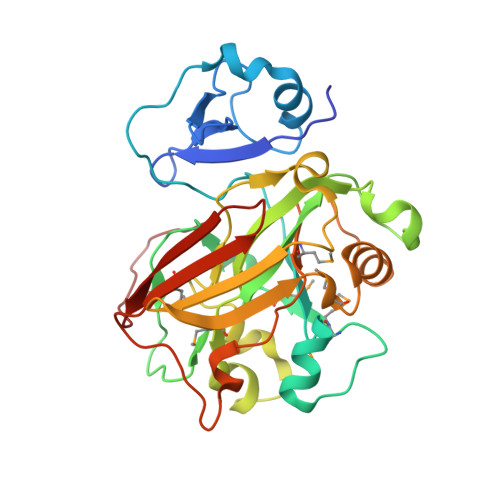Crystal Structure of l-2,4-Diketo-3-deoxyrhamnonate Hydrolase Involved in the Nonphosphorylated l-Rhamnose Pathway from Bacteria.
Fukuhara, S., Watanabe, S., Watanabe, Y., Nishiwaki, H.(2023) Biochemistry 62: 524-534
- PubMed: 36563174
- DOI: https://doi.org/10.1021/acs.biochem.2c00596
- Primary Citation of Related Structures:
8GSR, 8GST - PubMed Abstract:
2,4-Diketo-3-deoxy-l-rhamnonate (L-DKDR) hydrolase (LRA6) catalyzes the hydrolysis reaction of L-DKDR to pyruvate and l-lactate in the nonphosphorylated l-rhamnose pathway from bacteria and belongs to the fumarylacetoacetate hydrolase (FAH) superfamily. Most of the members of the FAH superfamily are involved in the microbial degradation of aromatic substances and share low sequence similarities with LRA6, by which the underlying catalytic mechanism remains unknown at the atomic level. We herein elucidated for the first time the crystal structures of LRA6 from Sphingomonas sp. without a ligand and in complex with pyruvate, in which a magnesium ion was coordinated with three acidic residues in the catalytic center. Structural, biochemical, and phylogenetic analyses suggested that LRA6 is a close but distinct subfamily of the fumarylpyruvate hydrolase (FPH) subfamily, and amino acid residues at equivalent position to 84 in LRA6 are related to different substrate specificities between them (Leu84 and Arg86 in LRA6 and FPH, respectively). Structural transition induced upon the binding of pyruvate was observed within a lid-like region, by which a glutamate-histidine dyad that is critical for catalysis was arranged sufficiently close to the ligand. Among several hydroxylpyruvates (2,4-diketo-5-hydroxycarboxylates), L-DKDR with a C6 methyl group was the best substrate for LRA6, conforming to the physiological role. Significant activity was also detected in acylpyruvate including acetylpyruvate. The structural analysis presented herein provides a more detailed understanding of the molecular evolution and physiological role of the FAH superfamily enzymes (e.g., the FAH like-enzyme involved in the mammalian l-fucose pathway).
- Department of Bioscience, Graduate School of Agriculture, Ehime University, 3-5-7 Tarumi, Matsuyama, Ehime 790-8566, Japan.
Organizational Affiliation:


















